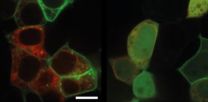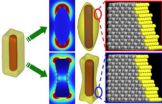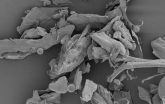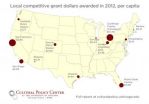(Press-News.org) The mitochondrial DNA of the first Near Eastern farmers has been sequenced for the first time. In the research, published in the journal PLOS Genetics, experts analysed samples from three sites located in the birthplace of Neolithic agricultural practices: the Middle Euphrates basin and the oasis of Damascus, located in today's Syria and date at about 8,000 BC.
The paper is signed by Daniel Turbón and Alejandro Pérez Pérez, from the Department of Animal Biology of the University of Barcelona (UB); Eva Fernández, from Liverpool John Moores University; Cristina Gamba, Eduardo Arroyo Pardo and Pedro Cuesta, from Complutense University of Madrid; Eva Prats, from the Spanish National Research Council, and Josep Anfruns and Miquel Molist, from the Universitat Autònoma de Barcelona (UAB). The study is focused on the analysis of mitochondrial DNA --a type of non-Mendelian maternally inherited DNA-- from the first Neolithic farmers, by means of samples obtained by the UAB research group which were first processed by the UB research group.
The Neolithic: a profound revolution in human societies
Agricultural and husbandry practices originated around 12,000 years ago in a region of the Near East known as the Fertile Crescent. This phenomenon, known as "Neolithic", meant a profound social, cultural and economic transformation of human populations (agricultural production, sedentary farming lifestyle, origin of the first cities and modern societies, etc.).
Eva Fernández, first author of the article who got her PhD from UB, explains that "the Neolithic Revolution rapidly expanded from these territories into Europe, where the hunter-gatherer subsistence economy --prevailing till then-- was replaced by an agropastoral producing system". To know the nature of the diffusion of the Neolithic --in other words, to know if it was a population migration process or a cultural adoption-- has been widely debated for the last fifty years. Different research fields, for instance archaeology, physical anthropology, linguistics and, more recently, human paleogenetics, have made contributions to the discussion.
The unknown genetics of first Near Eastern farmers
The genetic composition of first Neolithic populations was one of the mysteries of science till today, although some advances in European Neolithic populations' genetics were made during the last decade. Professor Daniel Turbón points out that the results revealed by the study published in PLOS Genetics "are the first ones regarding first Near Eastern farmers; in other words, the genetic stock of original Neolithic". However, it is important to remember that other data have been published about European first farmers, to be exact in Catalonia (by Cristina Gamba et al., 2012), the Basque Country (by Hervella et al.) and Germany (by Wolfgang Haak et al., 2010, and Brandt et al., 2013).
"Conclusions of previous studies --explains Turbón-- are based on the comparison with current Near East populations, as first agricultural societies' genetics have remained unknown until now".
From the Near East to Europe
The study published in PLOS Genetics provides a new framework to interpret the results of other studies about European Neolithic populations, stress the authors. According to conclusions, genetic affinities have been observed between the mitochondrial DNA of first Neolithic populations and the DNA of first Catalan and German farmers. This suggests that probably Neolithic expansion took place through pioneer migrations of small groups of population. Moreover, the two main migration routes --Mediterranean and European-- might have been genetically linked.
"The most significant conclusion --highlights Eva Fernández-- is that the degree of genetic similarity between the populations of the Fertile Crescent and the ones of Cyprus an Crete supports the hypothesis that Neolithic spread in Europe took place through pioneer seafaring colonization, not through a land-mediated expansion through Anatolia, as it was thought until now".
How did the Neolithic Revolution spread?
Other scientific studies had already provided signs of an alternative scenario of Neolithic spread in Europe different from the one through Anatolia. According to Turbón, "recent archaeological finds have proved that the Neolithic arrived to Cyprus around 10,600 years ago, some years after the first documentation of agricultural practices in the Near East". Architecture and burial models found in Cyprus' sites are similar to the ones found in the Middle Euphrates basin, "that indicates a direct colonisation of these territories", highlights the author. "Besides, spatial interpolation of radiocarbon dates from different Neolithic sites in the Near East and Europe also suggests a first seafaring expansion through Cyprus", he concludes.
In order to support these conclusions, the scientific team aims at analysing a greater number of human Neolithic samples from other regions of the Fertile Crescent, and at increasing the number of genetic markers analysed in the samples.
Mitochondrial DNA of first Near Eastern farmers is sequenced for the first time
2014-06-06
ELSE PRESS RELEASES FROM THIS DATE:
Herpesviruses undercover
2014-06-06
This news release is available in German.
The Kaposi's sarcoma-associated herpesvirus (KSHV), a gammaherpesvirus that can cause multiple forms of cancer, establishes lifelong infections within the body. To do so the virus has to find a way to modulate the immune system of its host.
„Intruders are usually fought off immediately by an antiviral immune response that is triggered by sensors including the toll-like receptors (TLR)," says HZI researcher Dr. Kendra Bussey, author of the study that was published in the "Journal of Virology". Toll-like receptors detect ...
Opening a wide window on the nano-world of surface catalysis
2014-06-06
Surface catalysts are notoriously difficult to study mechanistically, but scientists at the University of South Carolina and Rice University have shown how to get real-time reaction information from Ag nanocatalysts that have long frustrated attempts to describe their kinetic behavior in detail.
The key to the team's success was bridging a size gap that had represented a wide chasm to researchers in the past. To be effective as nanocatalysts, noble metals such as Au, Pt, Pd and Ag typically must be nanoparticles smaller than 5 nm, says Hui Wang, an assistant professor ...
Exotic particle confirmed
2014-06-06
This news release is available in French. For decades, physicists have searched in vain for exotic bound states comprising more than three quarks. Experiments performed at Jülich's accelerator COSY have now shown that, in fact, such complex particles do exist in nature. This discovery by the WASA-at-COSY collaboration has been published in the journal Physical Review Letters. The measurements confirm results from 2011, when the more than 120 scientists from eight countries discovered for the first time strong indications for the existence of an exotic dibaryon made ...
Early exposure to certain bacteria may protect toddlers from wheezing
2014-06-06
WHAT: Research funded by the National Institutes of Health (NIH) suggests that exposure to specific combinations of allergens and bacteria within the first year of life may protect children from wheezing and allergic disease. These observations come from the Urban Environment and Childhood Asthma (URECA) study, which aims to identify factors responsible for asthma development in children from inner-city settings, where the disease is more prevalent and severe. Since 2005, the URECA study has enrolled 560 children from four cities—Baltimore, Boston, New York and St. Louis. ...
New report: Local public grants for art varies across US
2014-06-06
Local direct public funding provided through grants for the arts in Chicago is low compared to peer regions in both total dollar and per capita terms, according to a new report from the Cultural Policy Center at the University of Chicago.
The study tracks direct public funding for the arts in 13 regions from 2002-2012. It provides a nuanced look at how much money comes to the nonprofit arts from national, state and local arts agencies, with an emphasis on the important role of local arts agencies. While most studies of public funding for the arts use appropriations made ...
HIV transmission networks mapped to reduce infection rate
2014-06-06
Researchers at the University of California, San Diego School of Medicine have mapped the transmission network of human immunodeficiency virus (HIV) in San Diego. The mapping of HIV infections, which used genetic sequencing, allowed researchers to predictively model the likelihood of new HIV transmissions and identify persons at greatest risk for transmitting the virus.
The findings are published online in the June 5 issue of the journal PLOS ONE.
"The more we understand the structure and dynamics of an HIV transmission network, the better we can identify 'hot spots' ...
Alcohol may protect trauma patients from later complications
2014-06-06
Injured patients who have alcohol in their blood have a reduced risk for developing cardiac and renal complications, according to a study from the University of Illinois at Chicago School of Public Health. Among patients who did develop complications, those with alcohol in their blood were less likely to die.
The study is published in the June issue of the journal Alcohol.
"After an injury, if you are intoxicated there seems to be a substantial protective effect," says UIC injury epidemiologist Lee Friedman, author of the study. "But we don't fully understand why this ...
Is glaucoma a brain disease?
2014-06-06
Rockville, Md. — Findings from a new study published in Translational Vision Science & Technology (TVST) show the brain, not the eye, controls the cellular process that leads to glaucoma. The results may help develop treatments for one of the world's leading causes of irreversible blindness, as well as contribute to the development of future therapies for preserving brain function in other age-related disorders like Alzheimer's.
In the TVST paper, Refined Data Analysis Provides Clinical Evidence for Central Nervous System Control of Chronic Glaucomatous Neurodegeneration, ...
Clinical review published in JAMA
2014-06-06
Many women experience bothersome urine loss with laughing, coughing and sneezing (stress urinary incontinence) AND on their way to the bathroom (urge urinary incontinence). When women experience both types of urine leakage, their condition is called mixed urinary incontinence. It is estimated that 20 to 36 percent of women suffer from mixed urinary incontinence, which is challenging to diagnose and treat because symptoms vary and guidelines for treatment are not clear.
A clinical review entitled "Clinical Crossroads – Female Mixed Urinary Incontinence" by Deborah L. ...
Prostate cancer biomarkers identified in seminal fluid
2014-06-06
Improved diagnosis and management of one of the most common cancers in men – prostate cancer – could result from research at the University of Adelaide, which has discovered that seminal fluid (semen) contains biomarkers for the disease.
Results of a study now published in the journal Endocrine-Related Cancer have shown that the presence of certain molecules in seminal fluid indicates not only whether a man has prostate cancer, but also the severity of the cancer.
Speaking in the lead-up to Men's Health Week (9-15 June), University of Adelaide research fellow and lead ...






